Abortion Methods and Pictures
Anyone who wants to understand the issue of abortion must understand how abortions work and their effect on children in the womb. Abortion is an inherently violent procedure that causes the death of a unique and developing human being. This is the reality of abortion.
RU-486 (Abortion Pill)
RU-486 is the most common abortion technique in Michigan, used up to 10 weeks. A woman will take mifepristone (RU-486) orally, which degrades the uterine lining, starving the developing baby. Between 24 and 48 hours later, the woman takes misoprostol to produce powerful contractions. The baby’s body is usually expelled within hours, while the woman is at home or at work—often in the toilet. RU-486 abortions can potentially be reversed if the woman has not taken the second pill.
Fetal development at 6 weeks:
Growth is rapid this week. Just four weeks after conception, the neural tube along your baby’s back is closing. The baby’s brain and spinal cord will develop from the neural tube. The heart and other organs also are starting to form. Structures necessary to the development of the eyes and ears develop. Small buds appear that will soon become arms. Your baby’s body begins to take on a C-shaped curvature.
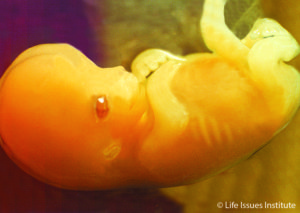
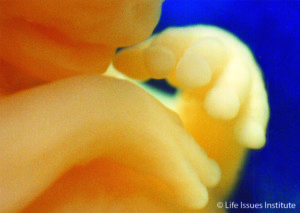
Suction Curettage (Vacuum Aspiration)
This is the second most common abortion technique in Michigan, mostly in the first trimester of pregnancy. In this procedure, the cervix is dilated and a powerful suction tube is inserted into the uterus. The vacuum dismembers the unborn child and sucks her body parts out of the womb.
Fetal development at 9 weeks:
In the 9th week of pregnancy, or seven weeks after conception, your baby’s arms grow and elbows appear. Toes are visible and eyelids form. Your baby’s head is large but still has a poorly formed chin.
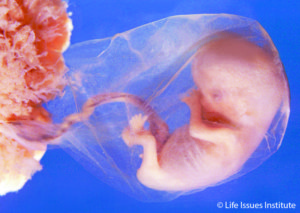
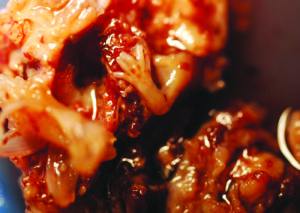
Dilation and Evacuation (D&E)
Also known as a dismemberment abortion, this procedure is the preferred second-trimester abortion procedure. The abortionist dilates the cervix and uses grasping forceps to tear off parts of the child: first the extremities, followed by the torso. The child’s head is often too large to be removed from the womb, so the abortionist must crush the skull before removal.
Fetal development at 16 weeks:
16 weeks into your pregnancy, or 14 weeks after conception, your baby’s head is erect. His or her eyes can slowly move. The ears are close to reaching their final position. Your baby’s limb movements are becoming coordinated and can be detected during ultrasound exams. However, these movements are still too slight to be felt by you.
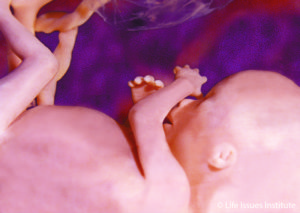
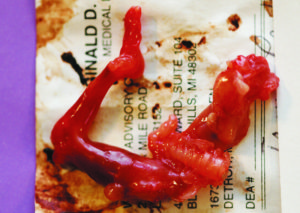
Saline Abortion
This procedure is rarely used anymore, and done in mostly in the second or third trimester. A needle is inserted into the woman’s abdomen and a saline solution (or similar substance) is instilled into the amniotic sac. The child breathes in the salt and is poisoned. It usually takes around an hour for the unborn child to die. After 33 to 35 hours the woman goes into labor and delivers a dead, shriveled baby.
Fetal development at 24 weeks:
24 weeks into your pregnancy, or 22 weeks after conception, your baby’s skin is wrinkled, translucent and pink to red because of visible blood in the capillaries. By now your baby might be about 8 inches long from crown to rump and weigh more than 1 1/3 pounds.
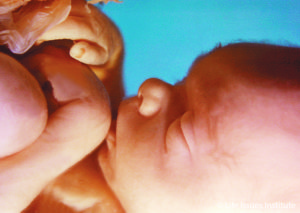
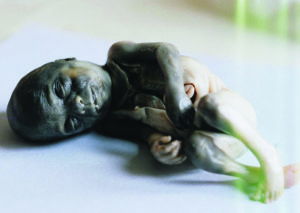
Fetal development pictures on this page courtesy of Life Issues Institute www.lifeissues.org
Abortion pictures on this page courtesy of Citizens for a Pro-Life Society www.prolifesociety.com
Fetal development descriptions courtesy of the Mayo Clinic www.mayoclinic.org
Resources
Abortion Pill Reversal
Have you taken the first dose of the abortion pill or RU-486 and regret your decision? It may not be too late to save your pregnancy! Visit the link below to get help.
Cruel and Usual Punishment
This LifeNotes edition offers in-depth explanations of methods used to perform abortions, as well as possible short-term, long-term, and psychological complications from the procedures. A PowerPoint presentation and presenter’s script is also available. The presentation does not utilize any graphic abortion photos but does provide detailed descriptions of abortion procedures used and compares them with detailed facts about fetal development.
Popping Pills, Ending Lives
Our LifeNotes edition gives in-depth information about the medical abortion pill, RU-486, including history, side effects, and the abortion pill reversal process.
The Dangers of Mail-Order Abortions
This brochure looks at the process involving abortion providers prescribing the medical abortion pill (RU-486) remotely, shipping them through the mail, with no physical meeting with a doctor.
Abortion Procedure Videos
The prolife group Live Action has produced a series of animated videos demonstrating the most common abortion procedures. The videos are narrated by a former abortionist.
Fetal Development
Learn more about the growth of a child in the womb with bi-weekly detailed descriptions of fetal development throughout the entire pregnancy.